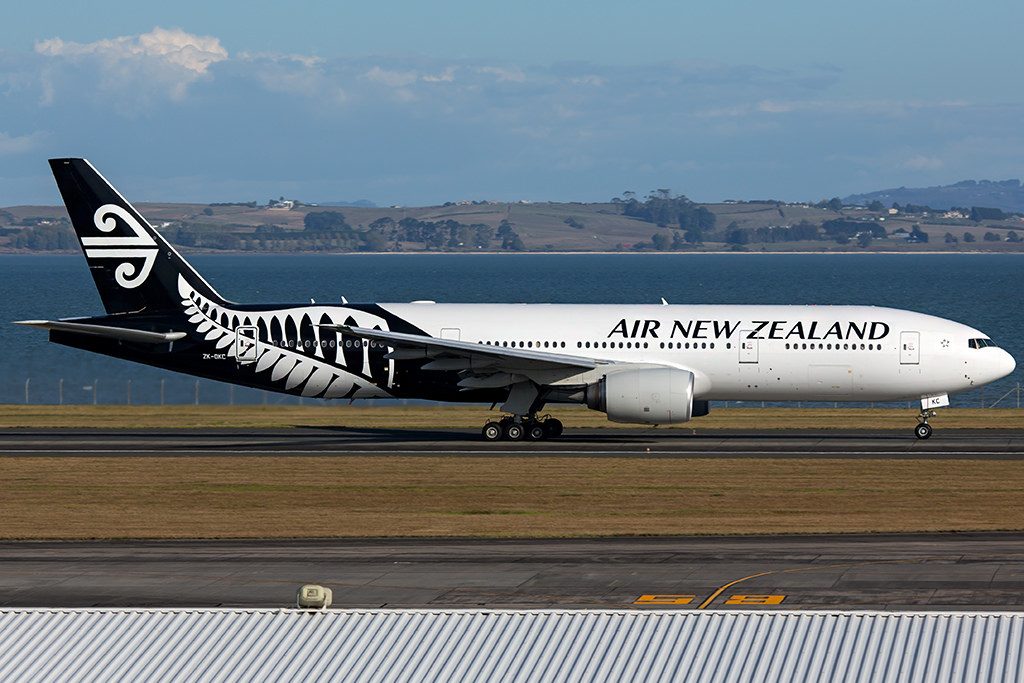Air New Zealand Boeing 777
%2C_ZK-OKO_-_LHR_(11344028005).jpg)
Airline enthusiasts will love this detailed aircraft model that is a work of art. This PacMin aircraft model is based off of true CAD data provided by airframe manufacturers. The models are made with polyurethane and ABS injection. All livery aspects are created using spot color matching approved by the airframe manufacturer as well as Air New Zealand. Air New Zealand is headquartered in a building called 'The Hub', located 20 km (12 mi) from Auckland Airport, in Auckland's Wynyard Quarter. Air New Zealand currently operates a fleet of Airbus A320, Airbus A320neo family, Boeing 777, and Boeing 787 jet aircraft, as well as a regional fleet of ATR 72 and Bombardier Q300 turboprop aircraft. Eight AirNZ Boeing 777 are in the fleet configured 26J/36W/242Y typically flown from Auckland to London Heathrow via Los Angeles, and Auckland to Hong Kong, Beijing, Shanghai, San Francisco and Vancouver. They occasionally crop up on Trans-Tasman Air New Zealand routes Auckland to Sydney, Brisbane, Perth and Melbourne.
Satellite images featuring grounded Air New Zealand aircraft have provided a glimpse into the impact the coronavirus pandemic has had on the global aviation sector.
Five Air New Zealand 777s, with their distinctive fern liveries, can be seen in Google Earth images of a plane graveyard in California's Mojave Desert.
When international air travel came to a near standstill in 2020 as a result of Covid-19 airlines grounded fleets and put planes into long term storage facilities in the dry heat of deserts, where they are less susceptible to corrosion.
In Air New Zealand’s case it sent 15 Boeing 777s to long term storage facilities in New Mexico, California and Auckland.
READ MORE:
* First of eight Air NZ Boeing 777-200ERs departs for desert 'plane graveyard'
* Coronavirus: Air NZ extends Boeing 777 groundings as international recovery outlook worsens
* Coronavirus: Three Air New Zealand Boeing 777-300ERs flown to plane graveyard in US desert
Last year was the worst on record for the aviation industry due to the impact of the Covid-19 pandemic, with full year traffic down around two thirds on 2019.
And the International Air Transport Association isn’t predicting 2021 will be much better with losses of US$39 billion (NZ$54b) forecast for the global industry over the year.
Satellite images show three Air New Zealand 777s parked at Victorville Southern California Logistics Airport surrounded by FedEx planes and a stone's throw from nine hibernating Qantas Airbus A380s.
Two more can be seen closer to the facility's operations centre.
The high desert facility is the same place Air New Zealand sent its retired Boeing 747-400s in 2014.

In September Air New Zealand said the 777s won’t be coming out of storage until September at the earliest.
The airline indicated to analysts last year that its 777-200ERs were no longer needed. If that were the case they could be sold to an air freight company or turned into scrap and sold for parts.
The grounding of its Boeing 777-200ER fleet alone resulted in a $338 million aircraft impairment charge, the airline said in August.
Frequent flyer Christopher Walsh of Money Hub said he had flown on the 777s numerous times including a 777-200ER flight to Narita, Tokyo in January 2020, not long before coronavirus became a global emergency.
He said it was a sad sight to see them parked up in the desert.
“They’re all boxed in there.
“I think it will be a while before we see them back, if ever.”
He said a generation of New Zealanders would have grown up travelling on those planes and in an instant they became redundant.
“This is our airline and now it’s on a scrap heap.”
The 777-300ERs were once a daily sight in London and Los Angeles before the pandemic. Air New Zealand no longer flies to London and operates just two return services per week to Los Angeles using Boeing 787-9 aircraft.
“It’s kind of the end of an era,” Walsh said.
Air New Zealand’s 777 fleet was made up of four owned and four leased 777-200ERs, and four owned and three leased 777-300ERs.
The 777-300ERs started entering the airline's fleet in late 2010, five years after it took delivery of its first 777-200ER.
The airline secured purchase rights for both fleets in a 2004 deal.
The four 777-300ERs it bought had a combined list price of $1.4b but airlines usually negotiate substantial discounts and the actual amount paid by the airline was kept secret.
My seat had access to 2 windows which was OK but I couldn't use the indent of the window as an armrest which is useful and gives that little bit more room to lean on.Air New Zealand Boeing 777-300er Review
 I paid extra for this seat as it was a 'preferred' seat which was supposed to give you priority boarding. The seat was just like all the other economy seats and they started boarding passengers seated in the rear first.
I paid extra for this seat as it was a 'preferred' seat which was supposed to give you priority boarding. The seat was just like all the other economy seats and they started boarding passengers seated in the rear first.Overall the whole flight was good, just annoyed about the preferred seat.